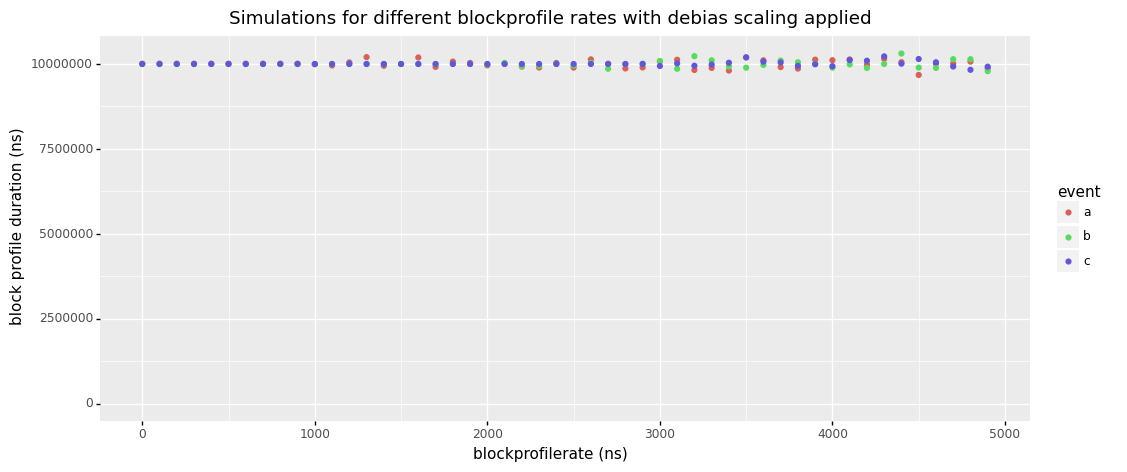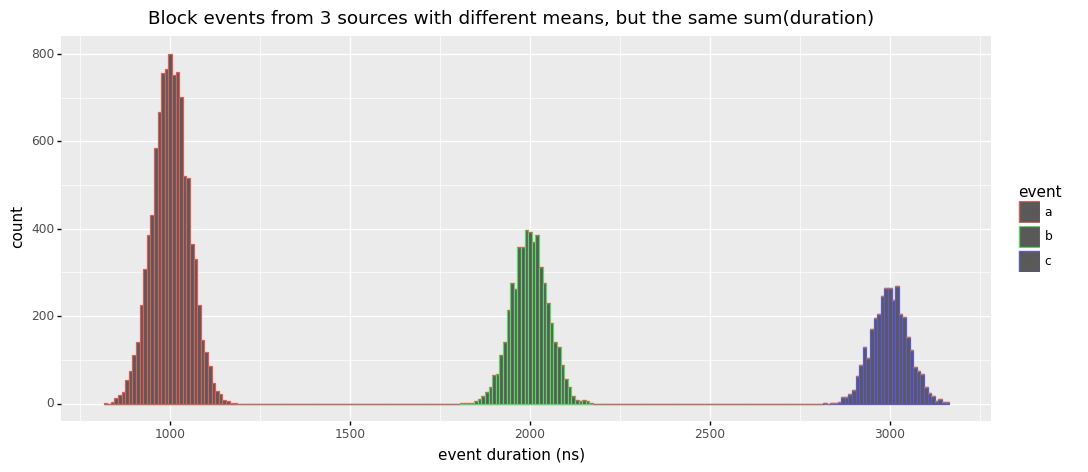Jay Taylor's notes
back to listing indexgo-profiler-notes/block.md at main · felixge/go-profiler-notes
[web search]This document was last updated for go1.15.7 but probably still applies to older/newer versions for the most parts.
Block Profiling in Go
- Description
- Usage
- Overhead
- Accuracy
- Relationship with Wall Clock Time
- Relationship with Mutex Profiling
- Profiler Labels
- pprof Output
- History
- Disclaimers
Description
The block profile in Go lets you analyze how much time your program spends waiting on the blocking operations listed below:
- select
- chan send
- chan receive
- semacquire (
Mutex.Lock,RWMutex.RLock,RWMutex.Lock,WaitGroup.Wait) - notifyListWait (
Cond.Wait)
Time is only tracked when Go has to suspend the goroutine's execution by parking it into a waiting state. So for example a Mutex.Lock() operation will not show up in your profile if the lock can be aquired immediately or via a short amount of spinning.
The operations above are a subset of the waiting states used by the Go runtime, i.e. the operations below will not show up in a block profile:
time.Sleep(buttime.After,time.Tickand other channel based wrappers will show up)- GC
- Syscalls (e.g. Network I/O, File I/O, etc.)
- Internal Locks (e.g. for stopTheWorld)
- Blocking in cgo calls
- Events that block forever (e.g. sending/receiving on nil channels)
However, some of the waiting states above above can be analyzed using Goroutine Profiling.
Usage
The block profiler is disabled by default. You can enable it by passing a rate > 0 as shown below.
runtime.SetBlockProfileRate(rate)
The rate impacts the Accuracy and Overhead of the profiler. In the docs the rate is described like this:
SetBlockProfileRate controls the fraction of goroutine blocking events that are reported in the blocking profile. The profiler aims to sample an average of one blocking event per rate nanoseconds spent blocked.
To include every blocking event in the profile, pass rate = 1. To turn off profiling entirely, pass rate <= 0.
Personally I struggle to parse the second sentence, and prefer to describe the rate (aka blockprofilerate) like this instead:
rate <= 0disables the profiler entirely (the default)rate == 1tracks every blocking event, regardless of the eventduration.rate => 2sets the sampling rate innanoseconds. Every event with aduration >= ratewill be tracked. For events with aduration < rate, the profiler will randomly sampleduration / rateevents. E.g. if you have an event with a duration of100nsand your rate is1000ns, there is a10%chance it will be tracked by the block profiler.
Block durations are aggregated over the lifetime of the program (while the profiling is enabled). To get a pprof formated snapshot of the current stack traces that lead to blocking events and their cumulative time duration, you can call:
pprof.Lookup("block").WriteTo(myFile, 0)
Alternatively you can use github.com/pkg/profile for convenience, or net/http/pprof to expose profiling via http, or use a continious profiler to collect the data automatically in production.
Last but not least you can use the runtime.BlockProfile API to get the same information in a structured format.
Overhead
tl;dr: A blockprofilerate >= 10000 (10µs) should have negligable impact on production apps, including those suffering from extreme contention.
Implementation Details
Block profiling is essentially implemented like this inside of the Go runtime (see the links in the Description above for real code):
func chansend(...) { var t0 int64 if blockprofilerate > 0 { t0 = cputicks() } // ... park goroutine in waiting state while blocked ... if blockprofilerate > 0 { cycles := cputicks() - t0 if blocksampled(cycles) { saveblockevent(cycles) } } }
This means that unless you enable block profiling, the overhead should be effectively zero thanks to CPU branch prediction.
When block profiling is enabled, every blocking operation will pay the overhead of two cputicks() calls. On amd64 this is done via optimized assembly using the RDTSC instruction and takes a negligible ~10ns/op on my machine. On other platforms various alternative clock sources are used which may have higher overheads and lower accuracy.
Depending on the configured blockprofilerate (more about this in the Accuracy section) the block event may end up getting saved. This means a stack trace is collected which takes ~1µs on my machine (stackdepth=16). The stack is then used as a key to update an internal hashmap by incrementing the corresponding blockRecord count and cycles.
type blockRecord struct { count int64 cycles int64 }
The costs of updating the hash map is probably similar to collecting the stack traces, but I haven't measured it yet.
Benchmarks
Anyway, what does all of this mean in terms of overhead for your application? It generally means that block profiling is low overhead. Unless your application spends literally all of its time parking and unparking goroutines due to contention, you probably won't be able to see a measurable impact even when sampling every block event.
That being said, the benchmark results below (see Methodology) should give you an idea of the theoretical worst case overhead block profiling could have. The graph chan(cap=0) shows that setting blockprofilerate from 1 to 1000 on a workload that consists entirely in sending tiny messages across unbuffered channels decreases throughput significantly. Using a buffered channel as in graph chan(cap=128) greatly reduces the problem to the point that it probably won't matter for real applications that don't spend all of their time on channel communication overheads.
It's also interesting to note that I was unable to see significant overheads for mutex based workloads. I believe this is due to the fact that mutexes employe spin locks before parking a goroutine when there is contention. If somebody has a good idea for a workload that exhibits high non-spinning mutex contention in Go, please let me know!
Anyway, please remember that the graphs below show workloads that were specifically designed to trigger the worst block profiling overhead you can imagine. Real applications will usually see no significant overhead, especially when using a blockprofilerate >= 10000 (10µs).
Block profiling utilizes a shared hash map that uses 1.4 MiB of memory even when empty. Unless you explicitly disable heap profiling in your application, this map will get allocated regardless of whether you use the block profiler or not.
Addtionally each unique stack trace will take up some additional memory. The BuckHashSys field of runtime.MemStats allows you to inspect this usage at runtime. In the future I might try to provide additional information about this along with real world data.
Initialization Time
The first call to runtime.SetBlockProfileRate() takes 100ms because it tries to measure the speed ratio between the wall clock and the TSC clock. However, recent changes around async preemption have broken this code, so the call is taking only ~10ms right now.
Accuracy
Sampling Bias
tl;dr: Setting your sampling rate too high will bias your results towards infrequent long events over frequent short events.
As described in the Usage section, the block profiler will sample as follows:
- Events with
duration >= ratewill be sampled 100% - Events with
duration < ratehave aduration / ratechance of getting sampled.
The implementation for this looks like that:
func blocksampled(cycles int64) bool { rate := int64(atomic.Load64(&blockprofilerate)) if rate <= 0 || (rate > cycles && int64(fastrand())%rate > cycles) { return false } return true }
This means that if you set your profiling rate low enough, you'll get very accurate results. However, if your rate is higher than the duration of some of the events you are sampling, the sampling process will exhibit a bias favoring infrequent events of higher duration over frequent events with lower duration even so they may contribute to the same amount of overall block duration in your program.
Simple Example
Let's say your blockprofilerate is 100ns and your application produces the following events:
A:1event with a duration of100ns.B:10events with a duration of10nseach.
Given this scenario, the blockprofiler is guaranteed to catch and accurately report event A as 100ns in the profile. For event B the most likely outcome is that the profiler will capture only a single event (10% of 10 events) and report B as 10ns in the profile. So you might find yourself in a situation where you think event A is causing 10x more blocking than event B, which is not true.
Simulation & Proposal for Improvement
For an even better intuition about this, consider the simulated example below. Here we have a histogram of all durations collected from 3 types of blocking events. As you can see, they all have different mean durations (1000ns, 2000ns, 3000ns) and they are occurring at different frequencies, with count(a) > count(b) > count(c). What's more difficult to see, is that the cumulative durations of these events are the same, i.e. sum(a) = sum(b) = sum(c), but you can trust me on that : ).
amd64 and other platforms use TSC for implementing the cputicks() function. This technique has been historically challenged by problems with frequency scaling and other kinds of CPU power transitions. Modern CPUs should provide invariant TSCs, but at least some Go users are still reporting issues. I can't tell whether those are due to broken hardware or issues regarding multi-socket systems, but hope to do more research on this in the future.
Please also note the bug description in the Initialization Time section which may impact the accuracy of converting cputicks to wall clock time.
Stack Depth
The max stack depth for block profiles is 32. Block events occurring at deeper stack depths will still be included in the profile, but the resulting data might be more difficult to work with.
Spin Locks
As described earlier, contended Go mutexes will first try to spin for a bit before yielding to the scheduler. If the spinning is successful, no block event will be tracked. This presents another subtle bias in the block profiler towards events of longer duration.
This section needs more research that I'll do as part of my mutex profiler note.
Relationship with Wall Clock Time
Blocking time is not bound by wall clock time. Multiple goroutines can simultaneously spend time blocking, which means it's possible to see profiles with a cumulative block duration that exceeds the runtime of the program.
Relationship with Mutex Profiling
The mutex profiling feature in Go overlaps with block profiling. It seems like both can be used to understand mutex contention. When using the mutex profiler it will report the Unlock() call sites rather than the Lock() call sites reported by the block profiler. The mutex profiler also uses a simpler and probably unbiased sampling mechanism which should make it more accurate. However, the mutex profiler does not cover channel contention, so the block profiler is a bit more flexible. When the mutex and block profiler are both enabled, it seems likely that some overhead will be wasted on tracking duplicate contention events.
This section needs more research that I'll do as part of my mutex profiler notes.
Profiler Labels
The block profiler does not support profiler labels right now, but it seems like this might be easy to implement in the future.
pprof Output
Below is an example of block profile encoded in pprof's protobuf format. There are two value types:
- contentions/count
- delay/nanoseconds
The blockprofilerate used to create the profile is not included, neither are profiler labels.
$ go tool pprof -raw block.pb.gz
PeriodType: contentions count
Period: 1
Time: 2021-02-08 14:53:53.243777 +0100 CET
Samples:
contentions/count delay/nanoseconds
22820 867549417: 1 2 3 4
22748 453510869: 1 2 5 4
Locations
1: 0x10453af M=1 runtime.selectgo /usr/local/Cellar/go/1.15.6/libexec/src/runtime/select.go:511 s=0
2: 0x10d082b M=1 main.simulateBlockEvents /Users/felix.geisendoerfer/go/src/github.com/felixge/go-profiler-notes/examples/block-sample/main.go:71 s=0
3: 0x10d0b72 M=1 main.eventB /Users/felix.geisendoerfer/go/src/github.com/felixge/go-profiler-notes/examples/block-sample/main.go:57 s=0
main.run.func2 /Users/felix.geisendoerfer/go/src/github.com/felixge/go-profiler-notes/examples/block-sample/main.go:33 s=0
4: 0x10d01b8 M=1 golang.org/x/sync/errgroup.(*Group).Go.func1 /Users/felix.geisendoerfer/go/pkg/mod/golang.org/x/sync@v0.0.0-20201207232520-09787c993a3a/errgroup/errgroup.go:57 s=0
5: 0x10d0b12 M=1 main.eventA /Users/felix.geisendoerfer/go/src/github.com/felixge/go-profiler-notes/examples/block-sample/main.go:53 s=0
main.run.func1 /Users/felix.geisendoerfer/go/src/github.com/felixge/go-profiler-notes/examples/block-sample/main.go:30 s=0
Mappings
1: 0x0/0x0/0x0 [FN]
History
Block profiling was implemented by Dmitry Vyukov and first appeared in the go1.1 release (2013-05-13).
Disclaimers
I work at Datadog on Continuous Profiling for Go. You should check it out. We're also hiring : ).
The information on this page is believed to be correct, but no warranty is provided. Feedback is welcome!




